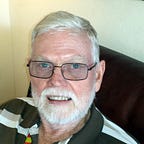The Celebration of Cyclone Dreaming (CCD) Part 7/15
Ta-Whiri-Ma-Tea — Prospering by engaging with a ‘cosmic adversary’
PROEM
In this series cyclones are personified as the embodiment of an intimate relationship between creativity and destructiveness. Our vulnerability is seen as the occasion for insight into resilience that transcends our material preoccupations. This disposition is placed alongside ancient ways of being in other cultures. The resonance of this (essentially a mystical response to existence) with aspects of Quantum theory evokes a dimension of technical work that recovers the wonder of encounter with the things and processes. Cyclones become the totem of a new Dreaming that is rooted in local environments and ancient human stewardship.
Where ever it is mentioned, Cyclone Dreaming is both a description of a way of relating to things and processes, and the name of any cyclonic event as totem — cyclone dreaming; and Cyclone Dreaming.
The list of posts: Vulnerability 1; Vulnerability 2; Wandjina; Nataraja, Prajana-Kurana; Wu-Wei; Ta-Whiri-Ma-Tea; Lolami; Quon; Metsat; El Nino — La Nina; Badi — Kulunggur; Cyclone Dreaming; The Celebration of Cyclone Dreaming; Tropical Cyclone Advice
CCD. 7 Ta-Whiri-Ma-Tea
In the Pacific, though there are several different cultures (Melanesian, Micronesian, and Polynesian to name but three of the broad groupings) there is a widely shared class of myth about the separation of the sky (father) from the earth (mother) by their offspring. In a Maori version, five of the six children (the progenitors of humanity, forests, cultivated food, fishes and reptiles, and wild grown food) collaborate in pushing the sky away from the earth. The wind TAWHIRIMATEA, however, is opposed to his siblings’ actions and drives the fishes into the sea and lays waste the forest. The earth shelters both kinds of food. Only humanity withstands the fury of the wind, though not without casualties and fear.
You don’t need to know how they did it to feel the awe that drove them.
This is true of of the peopling of the Pacific as well as the erection of the Moai.
Line drawing by the author
It is, of course, the very wind itself by which the oceanic peoples orient themselves in the world, naming the winds, not after the points of the compass, but according to their influence, and the points of the compass after the winds, which are differentiated into no fewer than thirty two distinct influences.
Line drawing by the author
It would be very difficult to imagine a more intimate image of human prosperity generated by its engagement with a ‘cosmic adversary’.
Resources for Ta-Whiri-Ma-Tea
The Eyes of Tawhirimatea Māori Myth PowerPoint
For a compelling account of how the Pacific was peopled, see:
Christina Thompson Sea People: In Search of the Ancient Navigators of the Pacific
WIND NAVIGATION FEAR COURAGE MYTHOLOGY
Prospering by engagement with a ‘cosmic adversary’
A shared Pacific Ocean myth is of humanity withstanding the fury of the wind and harnessing its power though not without fear and casualties.
POST SCRIPT
Global navigation was achieved in the 18th Century with the invention of the Marine Chronometer which enabled Captain James Cook and others to determine longitude and therefore to map the Pacific Ocean accurately — for mariners who lacked the skills that Pacific Islanders acquired routinely. https://en.wikipedia.org/wiki/Marine_chronometer
Poem Five Visions of Captain Cook by Kenneth Slessor
https://www.poetryfoundation.org/poems/47089/five-visions-of-captain-cook
